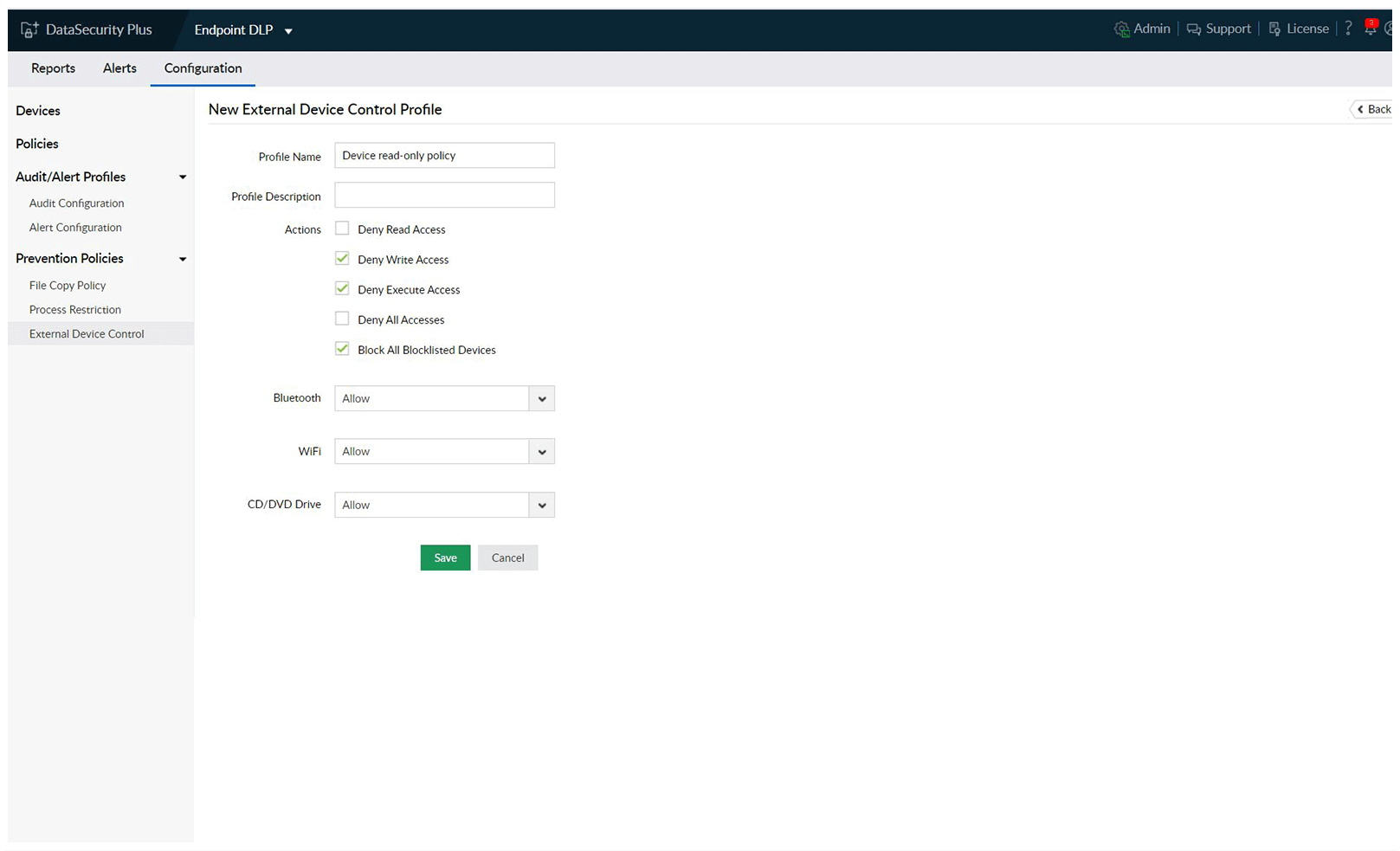Monitor and control the use of USBs, emails, printers, clipboards, and more across your organization.
Speed up incident detection with multiple predefined DLP security policies that help respond to unauthorized data movement, malware intrusion, and more.
Stop security incidents before they occur by blocking unwarranted file copy actions, stopping high-risk executables from running, and more.

1.Improved data control: Monitor and control the use of USBs, emails, printers, clipboards, and more across your organization.
2.Preconfigured security: Speed up incident detection with multiple predefined DLP security policies that help respond to unauthorized data movement, malware intrusion, and more.
3.Employ prevention strategies: Stop security incidents before they occur by blocking unwarranted file copy actions, stopping high-risk executables from running, and more.
Granularly control and limit external storage devices' capabilities like read, write, and execute access.
Direct which groups can access multiple endpoint devices, including Wi-Fi routers, Bluetooth adapters, CD/DVD drives, floppy drives, and more.
Create device blocklists to prohibit the use of suspicious and unvetted devices across your endpoints.

1.Control USB usage: Granularly control and limit external storage devices' capabilities like read, write, and execute access.
2.Manage endpoint devices: Direct which groups can access multiple endpoint devices, including Wi-Fi routers, Bluetooth adapters, CD/DVD drives, floppy drives, and more.
3.Restrict blocklisted device: Create device blocklists to prohibit the use of suspicious and unvetted devices across your endpoints.
Assess and handle critical policy violations using custom scripts or default remediation options for deleting and quarantining files.
Detect ransomware infections across local systems and initiate custom scripts to shut down the infected system, disconnect corrupted devices from the network, and more.

1.Activate threat management: Assess and handle critical policy violations using custom scripts or default remediation options for deleting and quarantining files.
2.Contain ransomware attacks: Detect ransomware infections across local systems and initiate custom scripts to shut down the infected system, disconnect corrupted devices from the network, and more.
Track the movements of highly sensitive files and configure policies to restrict both local and network file copy activities.
Pinpoint all movements of the file with restricted classification tags via removable media devices, email, printer, and more.

1.Implement file copy limitation: Track the movements of highly sensitive files and configure policies to restrict both local and network file copy activities.
2.Focus on what matters most: Pinpoint all movements of the file with restricted classification tags via removable media devices, email, printer, and more.
Gain in-depth visibility on all endpoint activities, including the use of removable devices, printers, emails, and more with with details on who did what, when, and where.
Identify the source, hostname, and time of all file copy events, and perform forensic analysis as and when needed.

1.Insights at a glance: Gain in-depth visibility on all endpoint activities, including the use of removable devices, printers, emails, and more with with details on who did what, when, and where.
2.Forensics made easier: Identify the source, hostname, and time of all file copy events, and perform forensic analysis as and when needed.
Gain visibility into data sharing patterns via cloud apps like Dropbox, Box, Sharepoint, Exchange, and more with detailed graphs.
Keep track of the top actors who frequently request access to unsanctioned, unencrypted, banned, and shadow cloud applications.

1.Analyze web usage: Gain visibility into data sharing patterns via cloud apps like Dropbox, Box, Sharepoint, Exchange, and more with detailed graphs.
2.Scrutinize unsafe requests: Keep track of the top actors who frequently request access to unsanctioned, unencrypted, banned, and shadow cloud applications.
Detect, disrupt, and prevent sensitive data leaks via endpoints, i.e., USBs and email.
Learn MoreDiscover sensitive personal data, and classify files based on their level of vulnerability.
Learn MoreAnalyze file security permissions, optimize disk space usage, and manage junk files.
Learn MoreMonitor, analyze, and report on all file server accesses and modifications in real time.
Learn MoreReport on enterprise web traffic, and control the use of web applications.
Learn MorePerfect your DLP strategy with this detailed guide on developing an effective DLP plan.